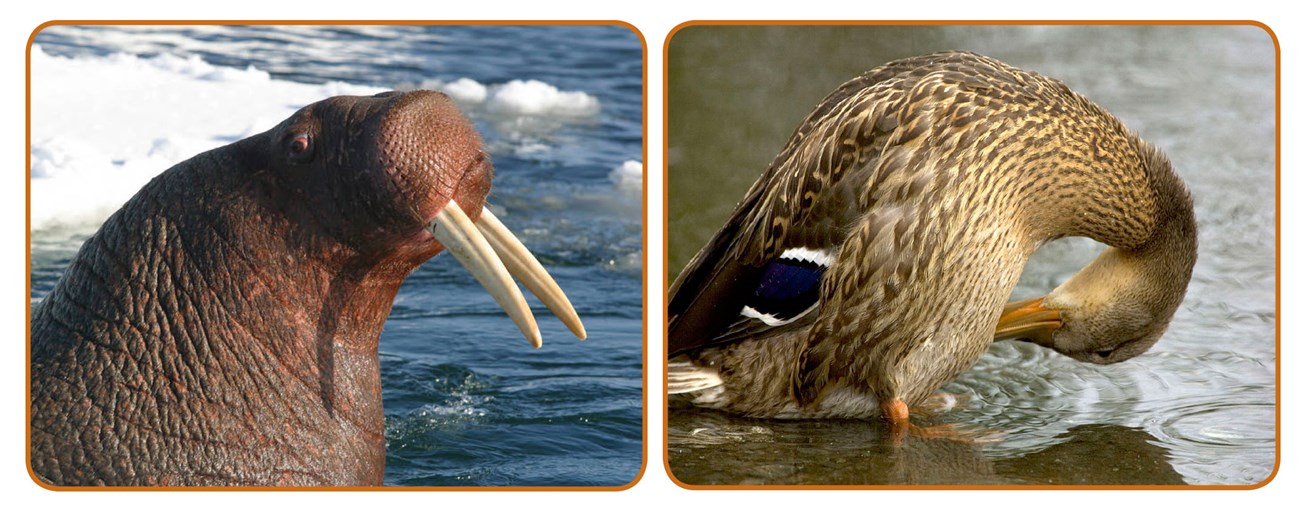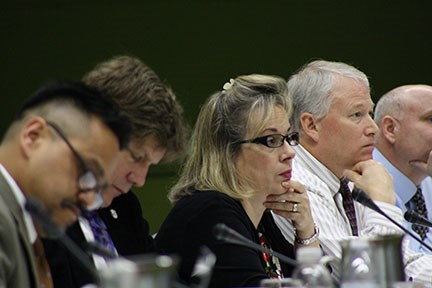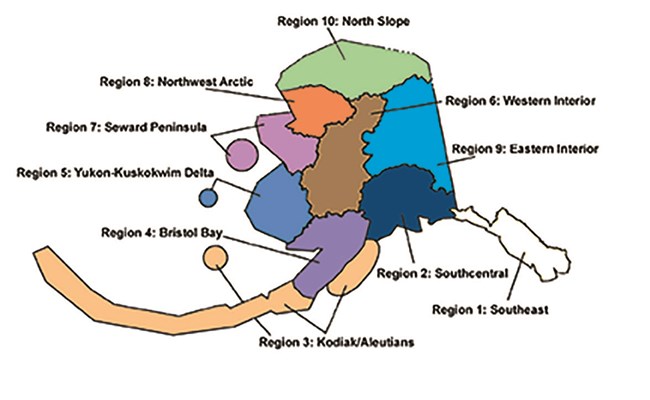
USFWS Photo
The Federal Subsistence Management Program
Harvest and use of natural resources for food, shelter, clothing, transportation, handicrafts, and trade, commonly called “subsistence,” has a long history in Alaska. Alaska Native peoples engaged in subsistence for thousands of years prior to statehood; living off the land is the core of Alaska Native peoples’ culture. In more recent history, non-Native people living in rural Alaska have come to rely on the natural resources for their livelihoods as well.
The Federal government’s involvement in the management of subsistence harvests is a historically recent event. The Federal Subsistence Management Program is responsible for management of harvest and use by rural Alaskan residents of land mammals taken on Federal public lands and harvest and use of fish taken from waters within and adjacent to Federal public lands.
Public involvement is the cornerstone of the Federal Subsistence Management Program. The public plays a vital role in proposing changes to subsistence fishing, hunting, and trapping regulations and making comments on proposed changes to ensure regulations are meeting the needs of subsistence users while conserving healthy populations of fish and wildlife. The Subsistence Regional Advisory Council meetings, which are held twice a year across the state, and the yearly Federal Subsistence Board meetings provide a forum for public involvement in the Federal Subsistence Management Program.

USFWS Photo
Other Laws Governing Subsistence Uses in Alaska
Marine Mammal Protection Act
Under the Marine Mammal Protection Act of 1972, the U.S. Fish and Wildlife Service manages sea otter, polar bear, and walrus in Alaska; the National Marine Fisheries Service manages seals, sea lions, whales, dolphins and porpoises. The Act provides Alaska Natives living on the coast of the North Pacific an exemption from the taking moratorium. The exemption allows for the non-wasteful harvest of marine mammals for subsistence and for creating and selling handicrafts and clothing. Amendments to the Act in 1994 also provide for co-management with Alaska Natives.
Migratory Bird Treaty Act
USFWS Photo
The Federal Subsistence Board
The Secretaries of the Interior and Agriculture delegated authority to manage the take of fish and wildlife resources for subsistence uses on Federal public lands in Alaska to the Federal Subsistence Board. The Federal Subsistence Board is the decision-making body that oversees the Federal Subsistence Management Program. It is made up of the regional directors or designees of the U.S. Fish and Wildlife Service, Bureau of Land Management, National Park Service, Bureau of Indian Affairs, and U.S. Forest Service.
A representative appointed by the Secretaries serves as the Board Chair. In addition, in 2012 the Secretaries expanded the Board’s membership to include two public members who possess personal knowledge of and direct experience with subsistence uses in rural Alaska.

USFWS graphic
The Regional Advisory Councils
Title VIII of ANILCA required the establishment of Regional Advisory Councils to provide recommendations and information to the Federal Subsistence Board, to review policies and management plans, provide a public forum and deal with other matters relating to subsistence uses. Under Federal regulations the Regional Advisory Councils have the authority to:
Each year, applications for Regional Advisory Council membership are solicited statewide. Applicants are interviewed by a selection panel that reports to the Interagency Staff Committee, which reports to the Federal Subsistence Board. The Federal Subsistence Board forwards on the applications with recommendations to the Secretaries of the Interior and Agriculture, who make the final selections.
The selection criteria include: residency within the region which the Council member would serve; knowledge of fish and wildlife resources; knowledge of subsistence uses, customs, and traditions; knowledge of commercial and sport uses; leadership ability and a willingness to travel. The Council membership appointments are up to three-year terms.
How Federal Subsistence Regulations are Developed
The Federal subsistence regulations are changed through a public process that begins with a call for proposals and culminates in a Federal Subsistence Board meeting to act on proposed changes. Proposals may request changes to season dates, harvest limits, methods and means of harvest or seek a customary and traditional use determination, which grants to residents of a community or area a priority for taking fish or wildlife in a specific area. Here is how the process works:
A call for proposals to change regulations is issued by the Federal Subsistence Board. The call for proposals to change wildlife hunting and trapping regulations is issued in January of odd-numbered years. The call for proposals to change fishing regulations is issued in January of even-numbered years.
Proposals to change fishing and hunting regulations are submitted. Regional Advisory Councils meet with the public to develop proposals for their region.
Proposals are published for review and public comment.
Proposals are analyzed by federal staff to examine the biological and socio-cultural effects of each proposal. A preliminary conclusion is offered for consideration by the affected Regional Advisory Council(s).
Regional Advisory Councils meet to review the analyses and public comments on proposals for their region. The Councils develop recommendations to the Federal Subsistence Board based on the analyses, tribal, ANCSA corporation, Alaska Department of Fish and Game, and public comments and their own knowledge of subsistence needs and uses.
Interagency Staff Committee meets to review proposals and Council recommendations, and develop its comments for the Federal Subsistence Board. The Interagency Staff Committee is made up of senior staff from the National Park Service, U.S. Fish and Wildlife Service, Bureau of Indian Affairs, Bureau of Land Management and U.S. Forest Service. The Alaska Department of Fish and Game participates to provide the state's perspective on proposals.
Federal Subsistence Board meets in January (Fisheries) or April (Wildlife) to take action on proposals. For each proposal the Board considers the Council recommendation(s), staff analysis, tribal, ANCSA corporation, Interagency Staff Committee, Alaska Department of Fish and Game and public comments. The Board can decide to adopt, reject, modify or defer action on any proposal.
New regulations are published and distributed to the public. Regulations are in effect for two years. Fishing regulations take effect April 1. Hunting and trapping regulations take effect July 1.
How to Submit a Proposal to Change Federal Subsistence Regulations
Alaska residents and subsistence users are an integral part of the Federal regulatory process. Any person or group can submit proposals to change Federal subsistence regulations, comment on proposals, or testify at meetings. Through involvement in the process, subsistence users assist with effective management of subsistence activities and ensure consideration of traditional and local knowledge in subsistence management decisions. Subsistence users also provide valuable fish and wildlife harvest information. Here is how the process works:A call for proposals to change regulations is issued by the Federal Subsistence Board. The call for proposals to change wildlife hunting and trapping regulations is issued in January of odd numbered years. The call for proposals to change fishing regulations is issued in January of even numbered years.
Submit your proposals. You may propose changes to Federal subsistence season dates, harvest limits, methods and means of harvest, and customary and traditional use determinations.
What your proposal should contain. There is no form to submit your proposal to change Federal subsistence regulations. Include the following information in your proposal submission (you may submit as many as you like):
• Your name and contact information (address, phone, fax, or email address)
• Your organization (if applicable)
• What regulations you wish to change. Include management unit number and species. Quote the current regulation if known. If you are proposing a new regulation, please state, “new regulation.”
• Write the regulation the way you would like to see it written in the regulations.
• Explain why this regulation change should be made.
• You should provide any additional information that you believe will help the Federal Subsistence Board in evaluating the proposed change.
How a proposal is processed.
1. Once a proposal to change Federal subsistence regulations is received by the Board, the U.S. Fish and Wildlife Service, Office of Subsistence Management (OSM) validates the proposal, assigns a proposal number and lead analyst.
2. The proposals are compiled into a booklet for statewide distribution and posted on-line at the Program website for comment. The proposals are also sent to the applicable Councils and the Alaska Department of Fish and Game (ADF&G) and the Interagency Staff Committee (ISC) for review. The period during which comments are accepted is no less than 45 calendar days. Comments must be submitted within this time frame.
3. The lead analyst works with appropriate agencies and proponents to develop an analysis of the proposal.
4. The analysis is sent to the Councils, ADF&G and the ISC for comments and recommendations to the Board. The public is welcome and encouraged to provide comments directly to the Councils and the Board at their meetings. The final analysis contains all of the comments and recommendations received by interested/affected parties. This packet of information is then presented to the Board for action.
5. The decision to adopt, adopt with modification, defer or reject the proposal is then made by the Board. The public has the opportunity to provide comment directly to the Board prior to the Board’s final decision.
6. The final rule is published in the Federal Register and a public regulations booklet is created and distributed statewide and on the Program’s website.
1. By mail or hand delivery to: Federal Subsistence Board Office of Subsistence Management Attn: Regulations Specialist 1011 E. Tudor Rd., MS-121 Anchorage, AK 99503
2. At any Federal Subsistence Regional Advisory Council meeting (A schedule will be published in the Federal Register and announced statewide, bi-annually, prior to the meeting cycle.)
3. On the Web. Submit a separate proposal for each proposed change; however, do not submit the same proposal by different accepted methods listed above. To cite which regulation(s) you want to change, you may reference 50 CFR 100 or 36 CFR 242 or the proposed regulations published in the Federal Register. All proposals and comments, including personal information, are posted on the Web.
How to Submit a Special Action Request to the Federal Subsistence Board
The regulatory cycle for changes to fish/shellfish and wildlife regulations take place every two years. A call for proposals to change fishing regulations is issued in January of even numbered years and odd numbered years for wildlife. A Special Action Request is an out-of-cycle change in a season, harvest limit, or method of harvest. Special Actions are taken when unusual situations arise, such as a significant change in resource abundance that could not reasonably have been anticipated. The Federal Subsistence Board may take a Special Action to restrict, close, open, or reopen the taking of fish and wildlife on Federal public lands and waters. Such actions are taken to ensure the continued viability of a particular fish or wildlife population, to ensure continued subsistence use, or for reasons of public safety. These guidelines and requirements can be found in 36 CFR 242.19 and 50 CFR 100.19.
Submit the Special Action Request by providing the following information:
• Your name and contact information (address, phone, fax, or email address)
• Your organization (if applicable).
• Describe the action you are requesting; reference the current regulations you wish to change
• List if there have been unusual or significant changes in resource abundance or unusual conditions affecting harvest opportunities that could not reasonably have been anticipated and that potentially could have significant adverse effects on the health of fish and wildlife populations or subsistence users
• State if requested action is to ensure the continued viability of a fish or wildlife population, to continue subsistence uses of fish or wildlife, or for public safety reasons
• State the extenuating circumstances that necessitate a regulatory change before the next regulatory review
How a Special Action Request is processed
1. A Special Action that is 60 days or less in duration is an emergency special action. A special action lasting 61 days or more is a temporary special action.
2. Special Actions are assigned to an analyst who works with the requester and field staff to develop an analysis and recommendation to the Federal Subsistence Board.
3. The analysis and recommendation is presented to the Interagency Staff Committee.
4. If the request is a temporary special action, a public meeting is held in the affected area(s) to allow for public comment.
5. If the timing of a regularly scheduled Council meeting permits without incurring undue delay, the Board may seek Council recommendations on proposed Emergency Special Actions.
6. If timing of a regularly scheduled Council meeting permits without incurring undue delay, the Board will seek Council recommendations on proposed Temporary Special Actions.
7. Prior to taking any action the Board (or ISC) will consult with ADF&G and the chairs of the affected Councils.
8. If there is unanimous consent of the ISC, the Assistant Regional Director for the Office of Subsistence Management, who has delegated authority, may approve the request.
9. If there is not unanimous consent of the ISC the analysis goes to the Board. The decision to adopt, adopt with modification or reject is then made by the Board.
10. Once a decision is made, a response letter, and a copy of the complete analysis and recommendations, is sent to the requesting proponent with a copy sent to the affected Council chair(s), ADF&G and Federal and State law enforcement.
11. If needed, the OSM subsistence outreach coordinator or the Federal agency requesting the Special Action will prepare a news release.
How to submit the completed Special Action Request
Mail:
Office of Subsistence Management
Attn: Subsistence Policy Coordinator
1011 East Tudor Road, Mail Stop 121
Anchorage, Alaska 99503-6199
Fax: (907) 786-3898
E-mail: subsistence@fws.gov
How to Submit a Request for Reconsideration
Any person who is adversely affected by a new Federal subsistence regulation may request the Federal Subsistence Board to reconsider its decision by filing a Request for Reconsideration (RFR). A Request for Reconsideration must be submitted in writing to the Federal Subsistence Board within 60 days after a regulation takes effect or is published in the Federal Register, whichever comes first. The written request must provide the Board with enough information to show why the action should be reconsidered. The Board will accept a Request for Reconsideration only if it is based upon information not previously considered by the Board; demonstrates that the information used by the Board is incorrect; or demonstrates that the Board’s interpretation of information, applicable law, or regulation is in error or contrary to existing law. These guidelines and requirements are found in 36 CFR 242.20 and 50 CFR 100.20. Please note that acceptance of the request only indicates the Board will reconsider the regulatory decision; however, it does not mean the Board will ultimately reverse the decision. Here is how the process works:
Submit the Request for Reconsideration by providing the following information:
• Your name and contact information (address, phone, fax, or email address)
• Your organization (if applicable).
• Provide the regulation that you wish the Board to reconsider and the date of Federal Register publication of that action
• Provide a detailed statement of how you are adversely affected by the action
• Provide a detailed statement of the issues raised by the Board’s action, with specific references to:
• information not previously considered by the Board and/or information used by the Board that is incorrect
• how the Board’s interpretation of information, applicable law, or regulation is in error or contrary to existing law
• Describe how you would like the regulation changed
How a Request for Reconsideration is processed
1. Once a RFR is received by the Board, the U.S. Fish and Wildlife Service, Office of Subsistence Management (OSM), assigns an RFR number and lead analyst.
2. The RFR is also sent out to the applicable Regional Advisory Council(s) (Council) and the Alaska Department of Fish and Game (ADF&G) for review (timelines vary depending on volume of requests).
3. The lead analyst prepares a threshold analysis to address if the RFR meets the criteria stated in regulations.
4. The threshold analysis is sent to the applicable Council(s), ADF&G and the Interagency Staff Committee (ISC) for comments and recommendations to the Board. The threshold analysis and all of the comments and recommendations are then presented to the Board for action. There is no set timeline for completion of the analysis.
5. If the Board decides the RFR does not meet the criteria, a letter is sent to the requester stating why the request was deemed invalid by the Board.
6. If the Board accepts the RFR, the lead analyst prepares a full analysis of the RFR. Again, this analysis is sent to the Council(s), ADF&G, and the ISC for comments and recommendations to the Board.
7. The Board is then presented with the analysis, comments, and recommendations and makes a final decision.
8. If the request is denied, the decision of the Board represents the final administrative action. If the request is passed, the regulations are revised and the public is notified of the change.
How to submit the Request for Reconsideration
Mail:
Office of Subsistence Management
Attn: Subsistence Policy Coordinator
1011 East Tudor Road, Mail Stop 121
Anchorage, Alaska 99503-6199
Fax: (907) 786-3898 E-mail: subsistence@fws.gov
Last updated: April 24, 2017
